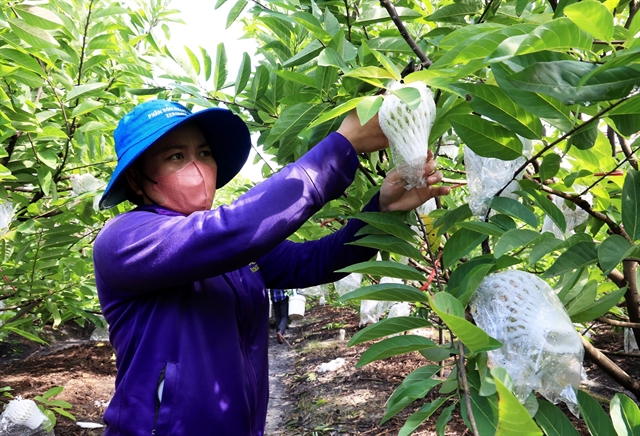 Society
Society

 |
| A custard apple orchard is grown in high-tech farming methods in Tây Ninh Province’s Tân Châu District. – VNA/VNS Photo Hồng Đạt |
TÂY NINH – Tây Ninh Province is boosting the development of high-tech agriculture to increase product value and develop agricultural production sustainably.
The south-eastern province has abundant human and natural resources and favourable weather for developing agriculture.
Nguyễn Đình Xuân, director of the province Department of Agriculture and Rural Development, said the province had identified agriculture as one of the pillars of its economy.
The province has many favourable conditions for developing agriculture as it has 341,897ha of farmland, accounting for 84.6 per cent of its total area, according to Xuân.
The agriculture sector makes many important contributions to the province’s socio-economic development.
More farmers in the province have increased the use of machines in their production to reduce labour costs and increase efficiency.
The use of machines is focused on the province’s key agricultural products such as rice, sugarcane and cassava.
In rice cultivation, the use of machines is 100 per cent for tilling, 2.9 per cent for sowing, 65-70 per cent for tending and 95-100 per cent for harvesting.
In sugarcane cultivation, the use is 100 per cent for tilling, 50-70 per cent for tending, and 40 per cent for harvesting.
Nguyễn Hữu Nghị, who has one of the largest sugarcane farming areas in the province, said this year he spent more than VNĐ10 billion (US$420,000) to buy machines for growing the cane.
He said he used machines to grow and harvest all his 310ha of sugarcane.
Previously, he hired about 100 workers to harvest sugarcane manually and they could harvest about 150 tonnes of cane a day, he said.
He now hires 15 workers to operate harvesting machines and they can harvest about 300 tonnes a day, he said.
With the use of machines for all cultivation stages, he earns a profit of VNĐ16-20 million (US$670-820) per hectare a year, he said.
Besides using machines to reduce labour costs, the province has increased growing high-value crops to improve production efficiency.
The province has turned about 7,640ha of farmlands that grow ineffective crops into growing fruits between 2020 and the first half of this year.
In animal husbandry, more farmers have switched from small-scale breeding to industrial breeding and farms.
The province has 627 animal farms and 107 poultry farms, up 12.6 per cent from 2020.
It has more than 10 million poultry, up 6.1 per cent against 2020.
The production value of agriculture is now VNĐ109 million ($4,500) per hectare a year, up VNĐ9 million ($370) from 2020.
The province has implemented 39 agriculture extension models to provide advanced farming techniques for farmers between 2020 and the first half of this year.
It has assisted farmers and organisations to implement origin traceability for 1,728ha of farming area and granted 130,500 origin stamps for five types of fruits – mango, green skin and pink flesh grapefruit, honeydew melon, Thai custard apple and Hoàng Hậu custard apple.
It has 15 farming areas totalling 552ha that have been granted production codes for exporting to China, the US and the EU.
However, the development of high-tech agriculture faces difficulties such as the small number of high-tech farming models and the shortage of workers who can use high-tech farming methods.
Nguyễn Thị Kim Oanh, director of the province Department of Science and Technology, said the Department of Agriculture and Rural Development should co-operate with relevant departments and agencies to research and apply science and technology in agriculture production to adapt to climate change, develop high-tech farming areas, and develop smart, clean, organic and ecological agriculture, and high-tech farms and agricultural co-operatives.
Her department would support the Department of Agriculture and Rural Development to develop agricultural products and the key products of craft villages which have advantages for becoming products under the country’s “One Commune-One Product” programme, and build brand names for agriculture, forestry and fishery products and craft villages’ key products, she said.
Investment
The province has invested in many irrigation systems to boost agricultural production.
It has built 48 infrastructure projects for agricultural production and clean water for rural areas worth a total of VNĐ559 billion ($23 million) between 2020 and the first half of this year.
A project providing irrigation for the west area of the Vàm Cỏ River has completed its first phase and serves to irrigate 17,000ha of farming areas.
To further develop high-tech agriculture, the province plans to develop 20 high-tech farming areas covering a total of 11,000ha in 2022-30.
They include 13 crop growing areas, five animal breeding areas, and two farming areas for both growing crops and breeding animals.
Xuân, director of the province Department of Agriculture and Rural Development, said the province had attracted many investors to invest in breeding animals.
Up to 148 animal breeding projects had been registered for investing in the province, and the province People’s Committee had approved 112 of the projects with a total investment capital of VNĐ9.6 trillion ($390 million), he said.
The approved projects breed chickens, pigs, cattle and goats.
Fifty-four approved projects have been implemented and operated. – VNS




